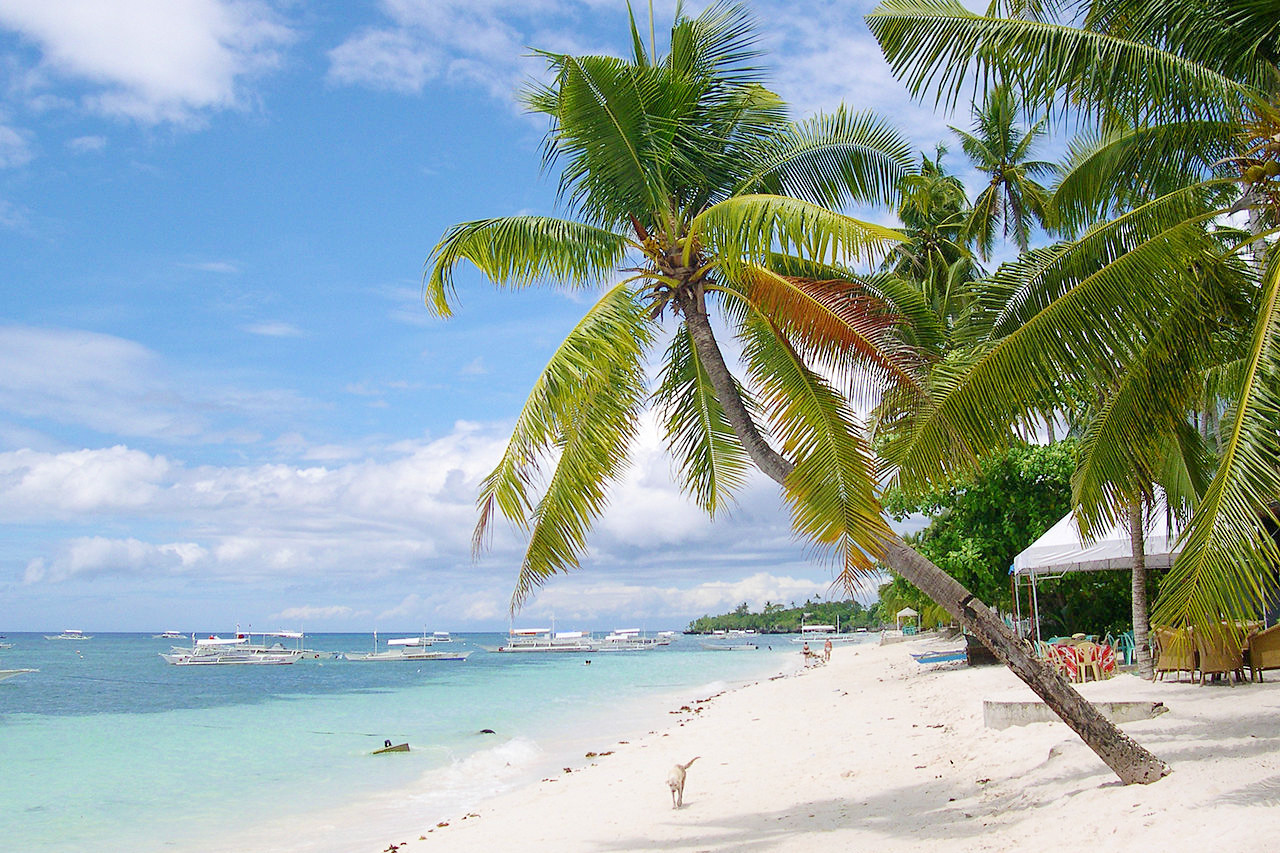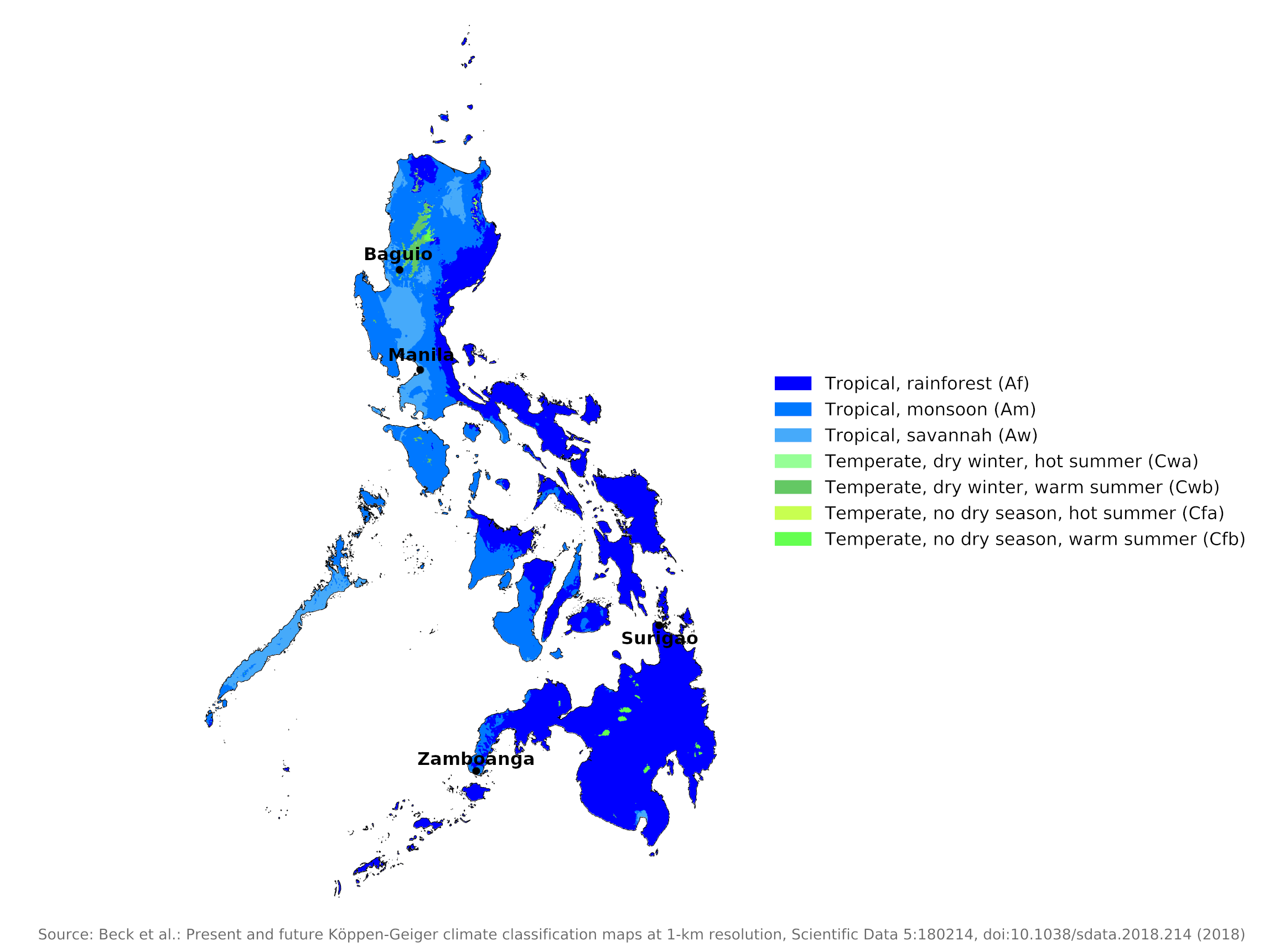The Climate of the
Philippines
 Alona beach on Panglao Island
Alona beach on Panglao Island
Climate Map
 Climate map of the Philippines
Climate map of the Philippines
What is the climate of the Philippines like?
The Philippines consists of an archipelago of over 7,000 islands in the western Pacific Ocean between 4° and 21°N. All of the larger islands are mountainous and have heavily indented coastlines, leaving the land with a rugged and intricate relief. There are many mountain ranges and isolated peaks that rise between 1,800 and 3,000 meters (6,000–10,000 feet). The area of the country is slightly larger than the United Kingdom.
The Philippines generally has a maritime tropical climate dominated by rainy and dry seasons. Except in the higher mountains, temperatures remain warm, with annual averages ranging from around 23 to 32°C (73 to 90°F) across the archipelago. Rainfall and seasons vary significantly across the islands as they experience differential exposure to the two major wind belts, the northeast trade winds or monsoon (winter) and the southwest monsoon (summer). In general, the east coasts receive heavy winter rainfall and the west coasts receive heavy summer rainfall. Central and southern regions receive smaller amounts that are more evenly distributed.
The southern islands have a near-equatorial climate with significant rainfall year-round—check out the climate of Zamboanga City in Mindanao. The central and northern islands have a tropical monsoon climate similar to that of Vietnam, with a single season of heavy rain. In most areas, the wettest period is July through October, when the western Pacific wind system is influenced by the monsoonal influence of the Asian continent. The winds then come from the southwest to the southeast. Check out the climate of Manila in Luzon. Manila and similar lowland areas are hot and dusty from March to May. Even at this time, however, temperatures rarely rise above 37°C (98°F).
| Climate data for Zamboanga City (1981–2010) | |||||||||||||
|---|---|---|---|---|---|---|---|---|---|---|---|---|---|
| Month | Jan | Feb | Mar | Apr | May | Jun | Jul | Aug | Sep | Oct | Nov | Dec | Year |
| Average high °C (°F) | 32.3 (90.1) | 32.6 (90.7) | 33.0 (91.4) | 33.1 (91.6) | 32.8 (91.0) | 32.1 (89.8) | 31.8 (89.2) | 32.1 (89.8) | 32.3 (90.1) | 32.2 (90.0) | 32.5 (90.5) | 32.5 (90.5) | 32.4 (90.3) |
| Daily mean °C (°F) | 27.9 (82.2) | 28.1 (82.6) | 28.5 (83.3) | 28.8 (83.8) | 28.8 (83.8) | 28.2 (82.8) | 28.0 (82.4) | 28.2 (82.8) | 28.3 (82.9) | 28.1 (82.6) | 28.2 (82.8) | 28.1 (82.6) | 28.3 (82.9) |
| Average low °C (°F) | 23.5 (74.3) | 23.6 (74.5) | 24.0 (75.2) | 24.4 (75.9) | 24.7 (76.5) | 24.4 (75.9) | 24.2 (75.6) | 24.3 (75.7) | 24.2 (75.6) | 24.0 (75.2) | 23.9 (75.0) | 23.7 (74.7) | 24.1 (75.4) |
| Average precipitation mm (inches) | 49.7 (1.96) | 43.7 (1.72) | 56.3 (2.22) | 69.0 (2.72) | 90.0 (3.54) | 149.1 (5.87) | 152.6 (6.01) | 144.9 (5.70) | 144.9 (5.70) | 178.9 (7.04) | 120.6 (4.75) | 66.8 (2.63) | 1,266.5 (49.86) |
| Source: Philippine Atmospheric, Geophysical and Astronomical Services Administration | |||||||||||||
| Climate data for Manila (1991–2020) | |||||||||||||
|---|---|---|---|---|---|---|---|---|---|---|---|---|---|
| Month | Jan | Feb | Mar | Apr | May | Jun | Jul | Aug | Sep | Oct | Nov | Dec | Year |
| Average high °C (°F) | 29.9 (85.8) | 30.7 (87.3) | 32.1 (89.8) | 33.8 (92.8) | 33.6 (92.5) | 32.8 (91.0) | 31.5 (88.7) | 31.0 (87.8) | 31.2 (88.2) | 31.4 (88.5) | 31.3 (88.3) | 30.3 (86.5) | 31.6 (88.9) |
| Daily mean °C (°F) | 26.9 (80.4) | 27.5 (81.5) | 28.7 (83.7) | 30.3 (86.5) | 30.3 (86.5) | 29.7 (85.5) | 28.7 (83.7) | 28.5 (83.3) | 28.4 (83.1) | 28.6 (83.5) | 28.3 (82.9) | 27.4 (81.3) | 28.6 (83.5) |
| Average low °C (°F) | 23.9 (75.0) | 24.3 (75.7) | 25.3 (77.5) | 26.7 (80.1) | 27.0 (80.6) | 26.5 (79.7) | 25.9 (78.6) | 25.9 (78.6) | 25.7 (78.3) | 25.7 (78.3) | 25.3 (77.5) | 24.6 (76.3) | 25.6 (78.1) |
| Average precipitation mm (inches) | 19.4 (0.76) | 21.9 (0.86) | 21.8 (0.86) | 23.4 (0.92) | 159.1 (6.26) | 253.3 (9.97) | 432.3 (17.02) | 476.1 (18.74) | 396.4 (15.61) | 220.6 (8.69) | 119.9 (4.72) | 98.5 (3.88) | 2,242.7 (88.30) |
| Source: Philippine Atmospheric, Geophysical and Astronomical Services Administration | |||||||||||||
Precipitation is particularly heavy from August to October, when much of it comes from tropical cyclones, called typhoons, in the South China Sea. The heaviest of these typhoons produce very high wind speeds and torrential rain. Most of them develop east of the Philippines and move west into the South China Sea where they deepen and intensify. Several typhoons hit part of the Philippines each year and the most severe cause widespread damage and loss of life from flooding and landslides, as well as wind damage.
Annual rainfall exceeds 1,000 millimeters (40 inches) almost everywhere, and where warm, humid Pacific air is forced to rise over coastal mountains, annual rainfall often exceeds 4,000 to 5,000 millimeters (160 to 200 inches). Coasts that face the northeast are exposed to the Pacific trade winds between November and March, and these areas experience the heaviest rainfall during this time. Check out the climate of Surigao City on the east side of the island of Mindanao.
| Climate data for Surigao City (1981–2010) | |||||||||||||
|---|---|---|---|---|---|---|---|---|---|---|---|---|---|
| Month | Jan | Feb | Mar | Apr | May | Jun | Jul | Aug | Sep | Oct | Nov | Dec | Year |
| Average high °C (°F) | 29.4 (84.9) | 29.9 (85.8) | 30.8 (87.4) | 32.0 (89.6) | 32.7 (90.9) | 32.6 (90.7) | 32.3 (90.1) | 32.7 (90.9) | 32.7 (90.9) | 32.0 (89.6) | 30.8 (87.4) | 29.9 (85.8) | 31.5 (88.7) |
| Daily mean °C (°F) | 26.3 (79.3) | 26.7 (80.1) | 27.3 (81.1) | 28.2 (82.8) | 28.8 (83.8) | 28.7 (83.7) | 28.5 (83.3) | 28.7 (83.7) | 28.7 (83.7) | 28.2 (82.8) | 27.4 (81.3) | 26.8 (80.2) | 27.9 (82.2) |
| Average low °C (°F) | 23.3 (73.9) | 23.5 (74.3) | 23.8 (74.8) | 24.4 (75.9) | 24.9 (76.8) | 24.8 (76.6) | 24.6 (76.3) | 24.7 (76.5) | 24.6 (76.3) | 24.4 (75.9) | 24.0 (75.2) | 23.7 (74.7) | 24.2 (75.6) |
| Average precipitation mm (inches) | 609.4 (23.99) | 446.4 (17.57) | 326.0 (12.83) | 219.1 (8.63) | 139.6 (5.50) | 142.1 (5.59) | 171.1 (6.74) | 133.9 (5.27) | 171.0 (6.73) | 240.7 (9.48) | 467.3 (18.40) | 585.2 (23.04) | 3,651.8 (143.77) | Source: Philippine Atmospheric, Geophysical and Astronomical Services Administration |
Temperatures remain fairly high year-round except in the mountains, but excessive heat is rare. The worst feature of the climate, apart from the occasional typhoon, is the high humidity and clouds during the rainy season; On many days the weather is muggy and oppressive. In the dry season the weather is more pleasant with plenty of sunshine averaging up to seven or eight hours a day, with refreshing sea breezes on the coast.
There are a number of mountain resorts such as Baguio, the summer capital, on the island of Luzon. Although temperatures can be much lower here, there can be more rain and clouds.
| Climate data for Baguio (1991–2020) | |||||||||||||
|---|---|---|---|---|---|---|---|---|---|---|---|---|---|
| Month | Jan | Feb | Mar | Apr | May | Jun | Jul | Aug | Sep | Oct | Nov | Dec | Year |
| Average high °C (°F) | 23.1 (73.6) | 23.7 (74.7) | 24.8 (76.6) | 25.5 (77.9) | 24.7 (76.5) | 24.3 (75.7) | 23.1 (73.6) | 22.3 (72.1) | 23.0 (73.4) | 23.6 (74.5) | 23.9 (75.0) | 23.5 (74.3) | 23.8 (74.8) |
| Daily mean °C (°F) | 18.1 (64.6) | 18.5 (65.3) | 19.7 (67.5) | 20.7 (69.3) | 20.6 (69.1) | 20.4 (68.7) | 19.6 (67.3) | 19.3 (66.7) | 19.6 (67.3) | 19.6 (67.3) | 19.5 (67.1) | 18.8 (65.8) | 19.5 (67.1) |
| Average low °C (°F) | 13.0 (55.4) | 13.4 (56.1) | 14.5 (58.1) | 15.9 (60.6) | 16.4 (61.5) | 16.5 (61.7) | 16.2 (61.2) | 16.2 (61.2) | 16.1 (61.0) | 15.6 (60.1) | 15.1 (59.2) | 14.1 (57.4) | 15.2 (59.4) |
| Average precipitation mm (inches) | 16.4 (0.65) | 23.7 (0.93) | 50.5 (1.99) | 99.5 (3.92) | 340.0 (13.39) | 406.1 (15.99) | 772.7 (30.42) | 963.2 (37.92) | 537.3 (21.15) | 477.3 (18.79) | 96.1 (3.78) | 41.6 (1.64) | 3,824.4 (150.57) |
| Source: Philippine Atmospheric, Geophysical and Astronomical Services Administration | |||||||||||||
References
- E. A. Pearce, Charles Gordon Smith, (1990) The Hutchinson World Weather Guide, John Murray Press. ISBN 1859863426
- Timothy L. Gall, (ed.), (2003), Worldmark Encyclopedia of the Nations, Eleventh Edition, Thomson Gale
- Federal Research Division, Library of Congress, (1993), Philippines: a country study. Claitor's Pub. Division. ISBN 0844407488.
- Hugh Chisholm, (ed.), (1911), Encyclopædia Britannica, Eleventh edition, Cambridge University Press
The Climate of the
Philippines

In summary:
The Philippines have a tropical maritime climate. There are two seasons which differ markedly throughout the islands; generally, the east coasts receive heavy winter rainfall (November through April) and the west coasts heavy summer rainfall (May through October). Intermediate and southern locales receive lesser amounts more equally distributed.
The average annual rainfall in the Philippines ranges from 1000 to 4000 mm (40 to 160 in).